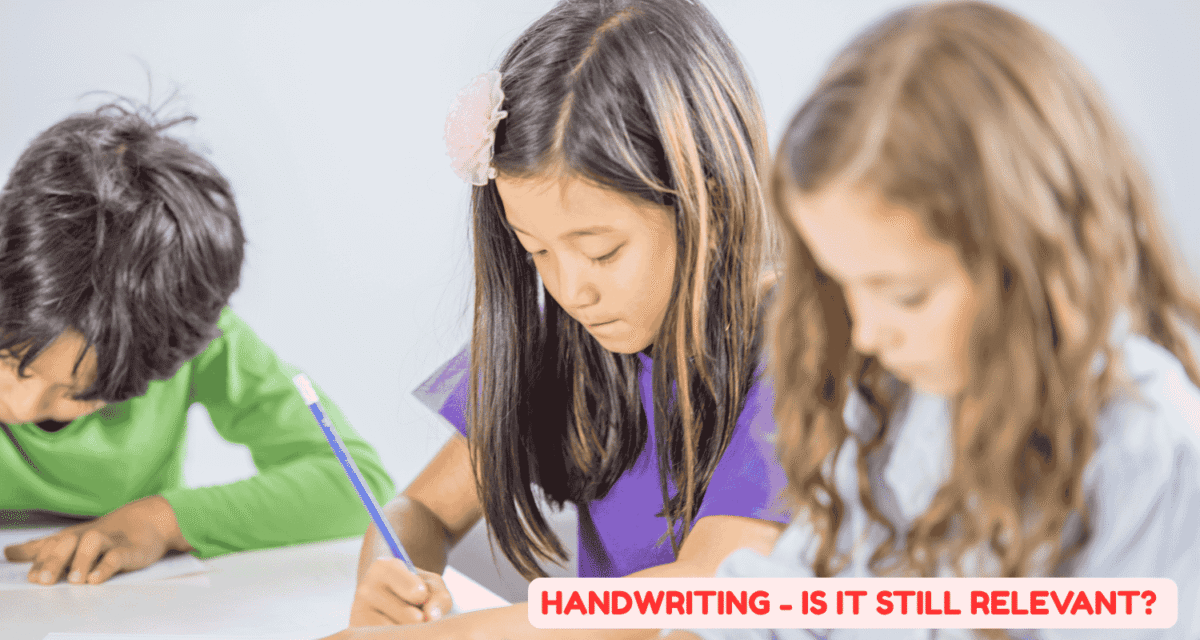Today, we’re going to talk about one very common mistake I see all the time when it comes to teaching reading.
And no, it’s not phonics vs. whole language vs. the balanced approach to teaching reading—also a very important conversation, by the way, and I’ve covered this topic several times in previous articles, like this one or this one.
But today I am talking about something else. Something insidious, something we are leaving behind without realizing, as we fully transition into the digital age and adapt our education to it.
*Affiliate Disclosure: Some links lead to Amazon marketplace. As an Amazon associate, I earn from qualifying purchases, at no additional cost to you). This helps keep the information on the blog free and available to everyone.
The Overlooked Foundation of Literacy
So what is it? What are we dangerously leaving behind?
We are forgetting about handwriting.
While this may sound old-school, this is a much bigger issue than it seems.
We live in a world of tablets, keyboards, apps, and artificial intelligence. Kids these days can swipe and tap on tables before they can tie their shoes. This is completely true, by the way, not an exaggeration! It’s all around us!
As a consequence, handwriting is fading.
People are giving much less importance to writing by hand than ever before. This is happening across the board: in elementary, middle, and high school.
This is not only sad, it’s also extremely concerning…
Let’s find out why!
What Research Reveals About Handwriting
Let me share with you the main conclusions of what Dr. Anabela Malpique and her research team found in a massive meta-study spanning over 20 yers of writing and handwriting studies.
Kids who write by hand actually write better.
They produce better writing when using pen and paper. When using pen and paper, children produce longer, clearer texts with higher-quality content compared to writing on a keyboard.
But that’s not all. Not at all. The benefits of handwriting go beyond basic writing mechanics.
Handwriting helps with spelling, memory, and even learning.
Yes, handwriting actively supports spelling development, memory retention, and overall learning processes.

When kids handwrite, they’re not just putting words on paper. They’re engaging the brain in ways that screens simply can’t match. They activate neural pathways that screens cannot replicate.
But here’s the thing…
While handwriting still gets some attention in elementary school, it’s probably way less than it used to be.
Why? Because we have this mindset that it’s not so important anymore—after all, everything will be done on computers anyway for these kids, right? And since tablets are now an integral part of the classroom, time spent on tablets is time not spent on pen and paper.
Then, as kids move into middle school and high school, handwriting basically disappears from the curriculum altogether.
This is a real missed opportunity, because teenagers still need handwriting—for taking notes, for staying focused, and for better processing and retaining information.
The Broader Implications of Handwriting for Learning
Yes, the benefits of handwriting go well beyond elementary school.
Students of all ages benefit from handwriting for effective note-taking, enhanced focus, and improved information processing and retention.
On a personal note, I couldn’t agree more.
Maybe it’s just me, but when I was a student, I used to write to remember. Nobody taught me this technique, but I discovered that if I wrote something down, I could remember it much better. So I did it all the time. It was one of my favorite tools for information retention.
Funnily enough I’ve also lately watched two interviews of two different authors that said they handwrite their books because it helps their brains work better. They said writing by hand made them sharper, more creative, more focused… that there was something special about the hand-mind connection!
Well, it turns out that there’s a lot of truth in their observations.
If you were curious, the two authors that I heard talking about this are:
Juan Manuel de Prada, renowned Spanish author who has won distinguished literary awards such as the Premio Planeta and the Spanish National Literacy Award. He handwrites the entire manuscripts of his books, and, then, get his dad to then type them! That’s a good dad! See this author on Amazon here
Robert Greene, American author of books on strategy and the rules of power. He has written seven international bestsellers. He uses handwriting, relying on a manual note card system to take notes, discover insights, and organize his ideas. He believes that handwriting helps him process information more deeply than typing on a computer. See this author on Amazon here.
The Reading Connection You Need to Know About
Let’s talk about learning to read specifically and handwriting.
What I see is that even when we teach reading to young children, writing is often overlooked, even though the two go hand in hand.
Kids today are doing way less writing than they used to in elementary school. In classrooms, children are already taking tests on iPads as early as first grade, and they are probably overusing it for many activities.
If you’ve been following me you know I’m not against digital tools in education. I believe they can have their place as long as they are truly educational, and don’t ingrain addictive components— story for another day, but if you want to learn more about this topic, I recommend watching my interview with Stephanie Barber (expert in technology and education) here.
In any case, digital tools (apps, softwares, audiovisual content) should always be supportive of, never a replacement of.

So my message here is:
While digital tools ARE helpful, if the digital shift is misunderstood and means children miss out on the foundational benefits of handwriting, then that’s a problem.
The Brain Science That Changes Everything
Now please, pay close attention to this other study, because this is huge, in my opinion, for anyone involved in literacy: parents, teachers, policy makers alike!
In one study carried out in 2012 and published in Trends in Neuroscience and Education, pre-literate five-year-olds — that is, young kids that did not know how to read yet — were divided into three groups:
- One was asked to trace some letters
- The other group typed the letters
- The third group wrote the letters by hand
After that, they were shown images of the same letters while their brain activity was measured using MRI technology…
And guess what? What happened?
A “reading circuit” in the brain was only activated in those children that had had the handwriting experience. It wasn’t activated in those that typed or traced the letters.
What does this mean?
At least, it clearly suggests that handwriting (the hand movement involved in writing) helps children form stronger brain connections, key for learning to read.
So when we skip handwriting, we may be skipping a key piece of the puzzle for successful reading instruction.
The Typing Problem Nobody Talks About
Here comes another interesting twist to the story!
Let’s assume that kids already know how to read and they are using computers on a regular basis now.
Do you know what? Children are also not learning how to type on a keyboard properly.
There’s this myth that assumes that since kids grow up with screens, they automatically know how to use them. But using a tablet or a phone is not the same as typing on a keyboard!

And it turns out, most kids can’t type well at all.
Again, coming back to Dr. Malpique’s research, they found that kids aren’t being taught keyboarding properly, or at all, and it really shows.
Many kids are stuck in the “hunt and peck” stage. That is, when you see a person that uses one or two fingers to locate and press the keys on the keyboard, but it’s a real struggle.
Why Motor Skills Matter
So what happens here?
Well, what happens is that typing, like writing by hand, is a learned motor skill. It takes practice, repetition and structure to become fluent. Just like learning to handwrite.
Being a fluent typer on a keyboard also matters.
Handwriting, but typing also, involves transcription skills: being able to spell quickly, and the ability to also quickly and accurately get ideas down on a paper, or a screen, before the idea flies away… or you start to doubt about the spelling of words because it just took too long to transcribe them!
So the more automatic these skills become, the better kids can express their thoughts.
When we don’t have to think about how to write, we can focus on what to write. That is what’s happening to these students that struggle with typing on a keyboard, and/or with handwriting.
What We Can Do About It
These are the takeaways here, in my opinion:
Let’s not forget about the importance of handwriting. For those teaching reading, don’t only focus on decoding, focus on teaching the letter and letter formation/letter writing at the same time. It’s ok to use an app, it’s ok to use screens, but you also want to do things on paper. The traditional way is superior. That’s the foundational skill, not the only way around.
Don’t drop handwriting after elementary school. Keep it going.
We need to teach typewriting, so probably we should make this a priority as well in the school or in our household. These days children know how to tap and swipe on screens, not necessarily how to type on a keyboard. The goal is raising hybrid writers: kids who can think and write fluently on paper and on screen. And that starts right from the beginning, with how we approach reading instruction.
The research is clear: handwriting isn’t just an old-fashioned skill. It’s a foundational tool that helps our brains learn, remember, and create. In our rush to embrace the digital future, let’s not forget the power of putting pen to paper.
What do you think?
I’d be really interested to know your thoughts about this. So don’t be shy, comment below — do your kids still write by hand? Have you ever noticed a difference in how you think when you write vs. when you type?
Resources for Further Research
The effects of handwriting experience on functional brain development in pre-literate children: https://pubmed.ncbi.nlm.nih.gov/25541600/
Effect sizes of writing modality on K-6 students’ writing and reading performance: a meta-analysis: https://link.springer.com/article/10.1007/s13384-023-00676-y

Hey there! I’m Laura – an author, YouTuber, blogger, and the creator of the “Learning Reading Hub” platform. I created this space to dive into the world of reading instruction and to shout from the rooftops about how vital it is to use the right methods for teaching reading. I’ve got a TEYL certification (Teaching English to Young Learners), plus a Journalism degree from the University of Navarra in Spain, along with a Master’s Degree in Communication.
I’ve always loved digging into research, jotting down my thoughts, connecting with people, and sharing what makes me tick. With a background in marketing, digital projects, and the education scene (especially language learning), I’m all about wearing different hats.
When my first kid needed to learn how to read, it opened my eyes to the challenges and complexities involved. This journey took me through a rollercoaster of self-teaching, eye-opening discoveries, and yeah, some letdowns too. There’s so much conflicting info out there, along with methods that just don’t cut it. And let’s face it, these issues are way too common.
Now, I’m all about channeling that passion (without sounding like a know-it-all!) and sharing my journey. My mission? Making it easier for those who are on the same path I once was.
My heart’s with my family and the amazing Learning Reading Hub project. I live with my husband and two little ones, raising them in a bi-lingual environment (English and Spanish).

